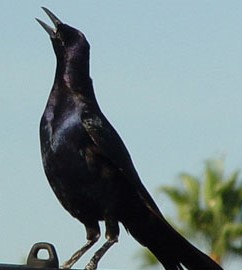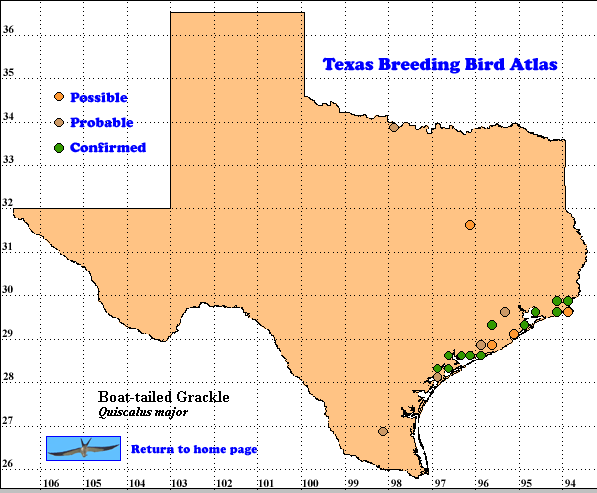The Boat-tailed Grackle is similar in appearance to the Great-tailed Grackle (Q. mexicanus); and these two species were formerly considered conspecific under the name Boat-tailed Grackle. The Boat-tailed Grackle is slightly smaller than the Great-tailed Grackle, and males of both species are noticeably larger than Common Grackle (Q. quiscula). In Texas most male Boat-tailed Grackles have a brown eye, contrasting with the yellow eye of Great-tailed Grackle. Habitat is a very useful clue in separating the 2 larger grackle species; the Boat-tailed Grackle is a resident of salt and brackish marshes whereas the Great-tailed Grackle resides in open country with scattered trees. Vocalizations and breeding displays are also useful in separating the grackle species.
Female Boat-tailed Grackles are cinnamon- colored and half the size of the males. They require experience to distinguish from other female grackles except in breeding season when they gather in colonial groups, while other grackles do not. Females in these colonies build nests and copulate with the most dominant males attending the colony; copulation must occur away from the nesting colony as well because DNA fingerprinting of males and young in the colony can only identify the fathers of 30-35% of the young whereas up to 85-90% of the copulations at the colonies have been observed. Males do not assist in rearing the young and breeding colonies breakup when the young become independent (Post et al. 1996).
DISTRIBUTION. During the 1987-1992 field work period of the TBBA project observers found Boat-tailed Grackles to be resident along the Gulf Coast from the Louisiana border southwest to the Rockport-Corpus Christi area. The unconfirmed records in latilong blocks 31096 and 33097 may be vagrants, data entry errors or mis-identifications.
Although Boat-tailed Grackles are colonial rather than territorial, in Texas they remain in the same general area all year.
Outside Texas, Boat-tailed Grackles breed discontinuously on the Atlantic Coast from Long Island, New York, south to the Chesapeake Bay and then continuously south to the tip of mainland Florida and along the Gulf Coast west to Louisiana (Post et al. 1996)
SEASONAL OCCURRENCE. TBBA workers found Boat-tailed Grackle females on nests from May 1-30, and feeding young from April 18 to June 4, suggesting May is the peak of the breeding season. Dates were gathered from various colonies and no one colony was followed through the entire breeding season. Oberholser (1974) reported the breeding season extends from early April to mid-July with egg dates from April 10 to May 8.
Breeding is synchronized in many colonies, particularly those where nests are placed in cattails or bulrushes (Post et al. 1996).
BREEDING HABITAT. Boat-tailed Grackles breed in coastal marshes and swamps with fresh, brackish or salt water. Within colonies females choose nest sites secure from ground predators such as snakes and rats, and high enough above water that the nest will not be flooded by high tides or rising fresh water levels. Small islands in swamps and marshes are favored, particularly where alligators patrol the surrounding water.
Nests are placed in cattails, shrubs or trees, generally 0.6-12 m (2-40 ft) above ground, and usually colonially (Oberholser 1974). The nest, built by the female, is a large, bulky open cup, woven from sticks, grasses, rushes, strips of bark, sedges, roots, eelgrass, Spanish moss, and vines, sometimes cemented with mud. The nest is woven around twigs or marsh vegetation
The female lays 3 ( mean 2.7, range 1-5) eggs, virtually indistinguishable from those of Great-tailed Grackle. The incubation period is about 13 days (Harrison 1979). The female provides all the care of nestlings and fledglings.
STATUS. The species is uncommon to locally abundant within50 km (30 mi) of the upper and central Gulf Coast (Lockwood and Freeman 2004). The TBBA map is indistinguishable from Oberholser’s map (1974), suggesting the range had not changed between 1972 and 1992.
The species is not sampled well by the Breeding Bird Survey (BBS) method since roads are few in the coastal habitat used by Boat-tailed Grackles. No statistically significant trend can be calculated from the data obtained on the 8 BBS routes on which this species was observed for the period 1966-2003 period. For the total United States range of Boat-tailed Grackle, a statistically significant 2.3% increase per year was calculated for the period 1966-2003 from BBS data (Sauer et al. 2004).
Comparison of the numbers of BBS routes on which Boat-tailed Grackles were observed in Texas and the United States (118) suggests that Texas represents about 7% of this species total range (Sauer et al. 2004). Text by Robert C. Tweit (2006)
Literature cited:
Harrison, H. H. 1979. A field guide to western birds’ nests. Houghton Mifflin, Boston, MA.
Lockwood, M. W. and B. Freeman. 2004. The TOS handbook of Texas birds. Texas A&M University Press, College Station.
Oberholser, H. C. 1974. The bird life of Texas, Vol. 2. University of Texas Press, Austin.
Post, W., J. P. Poston, and J. T. Bancroft. 1996. Boat-tailed Grackle (Quiscalus major). In The birds of North America, No. 207 (A. Poole and F. Gill, eds.). The Birds of North America, Inc., Philadelphia, PA.
Sauer, J. R., J. E. Hines, and J. Fallon. 2004 The North American Breeding Bird Survey, results and analysis 1966-2003 Version 2004.1. USGS Patuxent Wildlife Research Center, Laurel MD (Web site, http://www.mbr-pwrc.usgs.gov/bbs).

